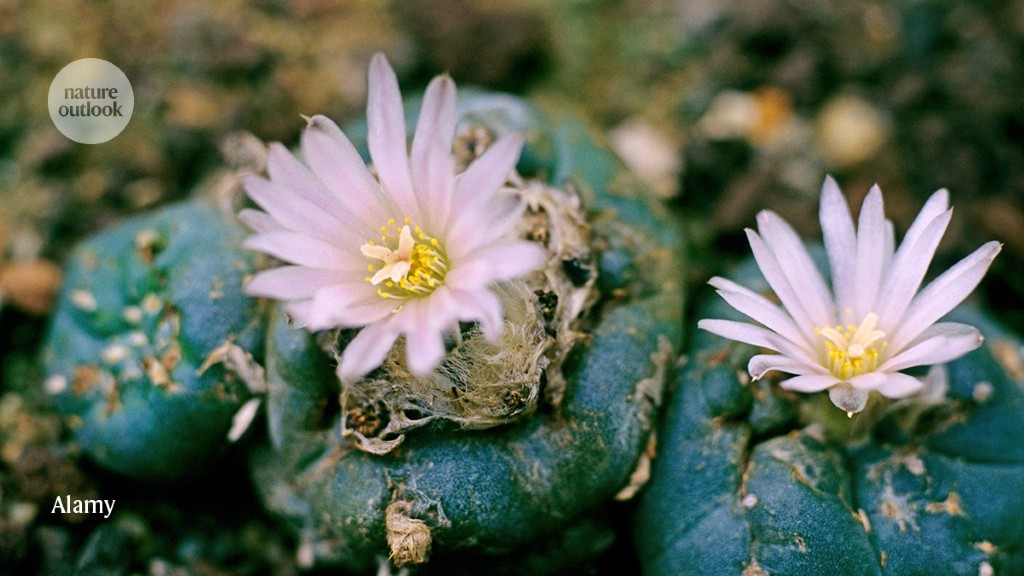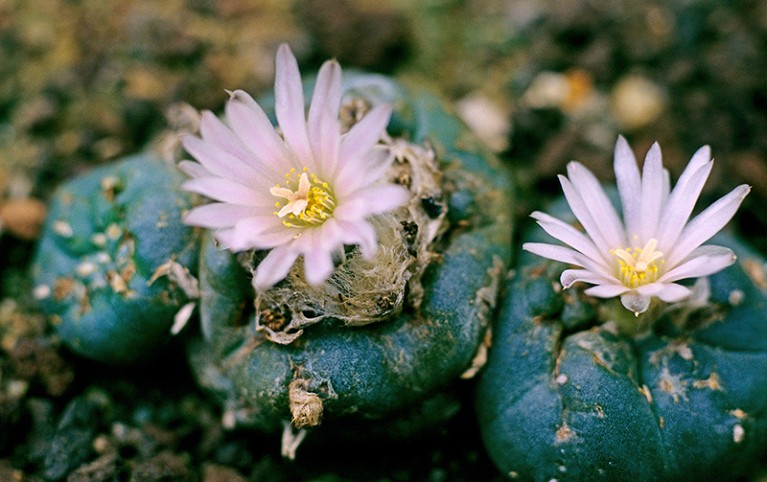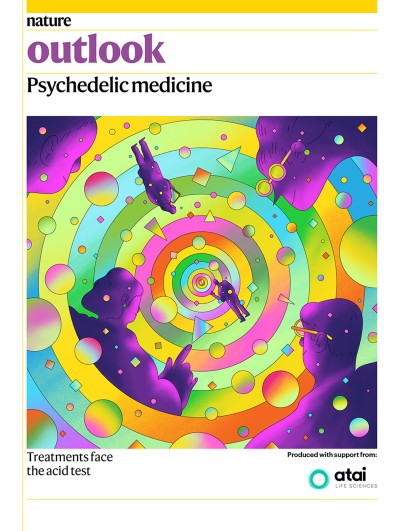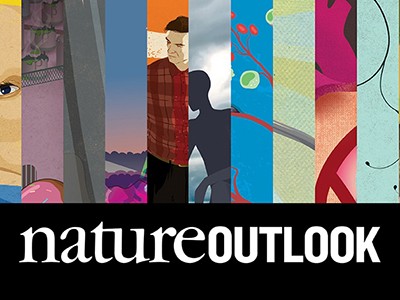The peyote cactus, Lophophora williamsii, is a source of the psychedelic drug mescaline.Credit: Alamy
For Alexander Shulgin, the twentieth-century biochemist often called the godfather of psychedelics, it all began with mescaline. “The world amazed me, in that I saw it as I had when I was a child,” he wrote1 about his first experience of the drug in 1960. “I had forgotten the beauty and the magic and the knowingness of it and me.”
Shulgin went on to synthesize hundreds of psychoactive substances, and other scientists focused mostly on LSD and psilocybin. Mescaline was largely forgotten, and almost disappeared from scientific studies when the United States and other countries clamped down on research on psychedelics in the 1970s.
Part of Nature Outlook: Psychedelic medicine
Mescaline is still barely visible in today’s explosion of interest in psychedelics and the rush to use them to create therapies. But a spate of new clinical trials could make mescaline a worthy competitor in the psychedelic sweepstakes.
Obtained from peyote and several other cacti in the Americas, mescaline has the longest known history of any psychedelic agent. Radiocarbon dating of peyote found in a cave above the Rio Grande in Texas suggests its use dates back at least 5,700 years2.
“Through the Native American Church and other groups, there are hundreds of thousands of people who regularly, consistently and safely use botanical forms of mescaline-containing plants, primarily peyote,” says Jeeshan Chowdhury, founder and chief executive of Journey Colab, a biotechnology company based in San Francisco, California.
Mescaline also led the way in early Western medical experiments using psychedelic agents. It was first identified by scientists in 1897 and synthesized in 1919. Systematic clinical trials began in Germany in the 1920s, says Simon Brandt, a forensic chemist at Liverpool John Moores University, UK.
Like psilocybin, mescaline is considered generally safe and not addictive. Like psilocybin and LSD, mescaline achieves its mind-altering effects primarily through the 5-HT2A receptor, which is usually triggered by the neurotransmitter serotonin. But unlike psilocybin and LSD, mescaline is a phenethylamine, a group that includes MDMA (also known as ecstasy), amphetamines and many other drugs.
Mescaline’s mechanism of action is quite different from those of most other psychedelics, says Rafael Lancelotta, a licensed professional counsellor and researcher at the Ohio State University in Columbus. Although mescaline activates the serotonin 5-HT2A receptor, like other psychedelics, it mimics adrenaline more closely than it does serotonin, Lancelotta says, adding that it acts rather like a cross between psilocybin and MDMA.
Slow to act
Of the well-known psychedelics, mescaline has the lowest potency in creating altered states of consciousness, at about 5% of the level of psilocybin. “It takes a really high dose to elicit psychoactive effects,” says Clinton Canal, a neuropharmacologist at Mercer University in Atlanta, Georgia. That’s a problem for drug development, because “if you have to take a high dose, you’re likely to engage a lot of other things in the body, which could potentially be toxic or have side effects”, he points out.
Also problematic from a conventional drug-development standpoint is mescaline’s slow onset of action and prolonged duration of 8 hours or more, which means treatments will require long sessions with healthcare providers. Psilocybin’s activity lasts for 4–6 hours — a little less, but still longer than drug companies, and those who pay for medical care, would like. Many therapists and some start-up drug companies are interested in 5-MeO-DMT, a psychedelic found in the glands of the Sonoran Desert toad, Incilius alvarius, and in various plants, which has a duration of just 15–30 minutes.
There is some debate about whether shorter is indeed better, however. “We don’t want to go shorter,” declares Gül Dölen, a neuroscientist at Johns Hopkins University in Baltimore, Maryland. Clinical research often shows a correlation between the acute subjective effects of a psychoactive drug and the duration of its therapeutic effects, Dölen says. For instance, ketamine’s acute effects typically last for less than 2 hours and its benefits seem to last for about a week, whereas ibogaine’s effects can last for days and its effects in countering heroin addiction can last for more than a year.
Dölen ties this correlation to critical learning periods — a well-established concept in neuroscience in which certain learning abilities are heightened during a specific window of time. For instance, people who experience a stroke are thought to be most likely to regain skills within six months of the event. Dölen’s group has demonstrated that various psychedelics can create periods of heightened social learning in mice that continue for weeks after the drug is administered.
Dölen hypothesizes that such extended periods of heightened learning underlie the dramatic improvements in depression, addiction and other conditions sometimes conferred by psychedelics. If that’s the case, longer-acting agents such as mescaline might prove more effective than faster-acting ones in dealing with well-entrenched memories and addictions, she suggests.
The clearest drawback of mescaline is that, for reasons that remain unclear, it can trigger nausea and vomiting. Mescaline drug-makers hope to minimize this obstacle through careful formulation of their products and guidelines for administration. Psilocybin and some other psychedelics can also induce nausea, but the risks are much lower.
Anecdotally, mescaline has been the favourite drug of many aficionados of psychedelics, as it brings altered states of consciousness in a relatively unthreatening way. It might be easier to navigate sessions with mescaline than with LSD because users are more likely to retain a helpful sense of their identities and surroundings.
As Shulgin wrote3 in 1979: “A benign attitude is taken towards nature, with the user experiencing feelings of benevolent and comfortable acceptance of sounds, images, animals and inanimate objects.” After 5–8 hours, this gives way to “a gentle recovery that allows personal integration of these stimuli into a peaceful and restful state of mind”.
These positive characteristics might also make it easier for patients to work with mental-health therapists. “The lack of dissolving of thought and self will make it a much more tolerable first-line agent for many people,” says Chowdhury.
The slow onset of the mescaline high could also be an asset for people who might be overwhelmed by the rapid onslaughts of psilocybin and LSD, says Peter Hendricks, a clinical psychologist and addiction researcher at the University of Alabama at Birmingham. It’s possible, he says, that slower onset might allow for greater “surrender” to the psychedelic experience, and provide greater therapeutic benefit as a result.
An online survey of 452 self-selected users of mescaline highlights the opportunity for psychiatric improvements, says Gabrielle Agin-Liebes, a clinical psychologist and researcher at the University of California, San Francisco, who is lead author on a 2021 paper4 about the survey. Two-thirds or more of the respondents who had depression, anxiety, post-traumatic stress disorder or drug-use disorder reported improvements in those conditions following their “most memorable” mescaline experience. Notably, she says, very few of them took the drug with that explicit intention.
The doors to prescription
The first modern clinical trial of mescaline is being led by pharmacologist Matthias Liechti at the University Hospital in Basel, Switzerland. With about 30 healthy volunteers, the study compares the effects of LSD, psilocybin and mescaline, using psychological and physical assessments, including functional magnetic resonance imaging. This year, Liechti and his collaborators launched a mescaline dosing study involving 16 volunteers. Liechti expects to complete both studies by mid-2023.
These two trials are primarily academic studies designed to test and generate hypotheses, says psychiatrist Daniel Karlin, chief medical officer of MindMed, a start-up based in New York City that is footing most of the bill for the mescaline dosing study. “We would hate for something like mescaline to be left behind, if, in fact, it has characteristics that make it a good treatment.”
Several other start-ups are going ahead with trials to study mescaline treatments for mental-health conditions. Journey Colab will launch an ascending-dose study in the next year for alcohol misuse, conducted by the Centre for Human Drug Research in Leiden, the Netherlands. Mescaline has an empathogenic aspect that will aid in addiction therapy by boosting connections between patients and the care team and other people recovering from addiction, Chowdhury argues.
Mescaline’s history of sacramental use highlights the need to administer the drug as part of an extended therapy with support from caregivers and the community, says Chowdhury. He characterizes Journey Colab’s model as “surgery for the mind, where there’s pre- and post-operative care”. People will be treated in the equivalent of a psychedelic operating room with a trained psychosocial therapy team. Afterwards, psychological rehabilitation will continue with caregivers and support groups for as long as needed.
Biomind Labs, a biotech company based in Toronto, Canada, is now developing a drug based on mescaline that targets inflammation, which is associated with several types of depression. Its clinical trial will be run by the Albert Einstein Israelite Hospital in São Paulo, Brazil.
More from Nature Outlooks
XPhyto Therapeutics, based in Vancouver, Canada, this year announced plans for a phase I clinical trial to evaluate the safety and dosage of a mescaline-based treatment that might aid in a broad range of mental-health conditions. The company’s mescaline formulation aims to minimize nausea and deliver more predictable onset times, says Raimar Löbenberg, an XPhyto director and pharmacologist at the Drug Development and Innovation Centre at the University of Alberta in Edmonton, Canada.
Several biotech start-ups are engineering analogues of mescaline. They are saying little about these early efforts, but the compounds are expected to take on the main challenges of reducing the duration and lessening the chances of nausea.
Large numbers of modified mescaline compounds have been created over the decades, and some might eventually prove advantageous, but they must all start from scratch in demonstrating safety and efficacy. “You don’t know whether any of them are going to be any good for anything at all,” says David Nichols, a medicinal chemist at the University of North Carolina at Chapel Hill and professor emeritus at Purdue University in West Lafayette, Indiana. Nichols also co-founded the Heffter Research Institute of Santa Fe, New Mexico, which funds trials of psychedelic medicine.
Mescaline’s prospects as a treatment should be clearer next year, when Liechti and his colleagues report the results of their two trials, and results begin to arrive from the corporate-sponsored studies of mescaline for addiction and other conditions. So far, mescaline, LSD and psilocybin seem to “have a relatively similar mode of action and produce overall relatively similar effects in humans”, says Liechti.
Whatever role mescaline or any other psychedelic eventually has, therapists emphasize the need to focus on the treatment, rather than the drug. “I just hope,” says Agin-Liebes, “that we will continue to be mindful about how you incorporate them in a larger process of healing and therapy — and not as a quick fix.”









More News
Could bird flu in cows lead to a human outbreak? Slow response worries scientists
US halts funding to controversial virus-hunting group: what researchers think
How high-fat diets feed breast cancer